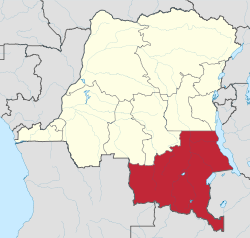Shaba II
| Shaba II | |||||||
|---|---|---|---|---|---|---|---|
| Part of the Shaba Invasions and the Cold War | |||||||
 Location of Shaba in Zaire. | |||||||
| |||||||
| Belligerents | |||||||
|
| |||||||
| Commanders and leaders | |||||||
|
|
| ||||||
| Casualties and losses | |||||||
|
Zaire: Military: 14 killed 8 wounded[1] Civilian: 500 killed France:[1] 11 killed 20 wounded Belgium:[1] 1 killed Morocco:[1] 1 paratrooper killed European civilians: 120 killed[1] United States:[1] 1 aircraft slightly damaged 1 crewman wounded |
Katanga:[1] 250 killed 160 captured | ||||||
Shaba II was a brief conflict fought in the Zairean province of Shaba (now Katanga) in 1978. The conflict broke out on 11 May 1978 after 6,500 rebels from the Congolese National Liberation Front (FNLC), a Katangese separatist militia, crossed the border from Angola into Zaire in an attempt to achieve the province's secession from the Zairian regime of Mobutu Sese Seko. The FNLC captured the important mining town of Kolwezi.[2]
The Mobutist government appealed for foreign assistance and French and Belgian military intervention beat back the invasion just as in 1977.[3]
The U.S. and Cuba coerced Angola and Zaire into negotiations leading to a non-aggression pact. This ended support for insurgencies in each other's respective countries. Zaire temporarily cutoff support to the Front for the Liberation of the Enclave of Cabinda (FLEC), the National Liberation Front of Angola (FNLA), and National Union for the Total Independence of Angola (UNITA) and Angola forbade further activity by the Shaba separatists.[3]
The U.S. worked with France in repelling the invaders, the first military cooperation between the two nations since the Vietnam War.[2] U.S. Air Force elements involved included a Combat Control Team (air traffic controllers) of the 435th Tactical Airlift Wing, the 445th Military Airlift Wing, and other airlift wings.[4]
Battle of Kolwezi
Six hundred troops of the French Foreign Legion's 2 Foreign Paratroop Regiment took back Kolwezi after a seven-day battle and airlifted 2,250 European citizens to Belgium, but not before the FNLC massacred 80 Europeans and 200 Africans. In one instance the FNLC killed 34 European civilians who had hidden in a room. However, Pierre Yambuya claims many of the civilian deaths were caused by FAZ-troops and not the FLNC.[5]
The FNLC retreated to Zambia and back to Angola, vowing to return. The Zairian armed forces (Forces Armées Zaïroises) then forcibly evicted civilians along Shaba's 105-kilometre-long (65 mi) border with Angola and Mobutu ordered them to shoot on sight.[6]
See also
References
- 1 2 3 4 5 6 7 Ministère de la Défense. ""OPÉRATION LÉOPARD" Une intervention humanitaire Kolwezi 17 mai-16 juin 1978" (PDF). Collection « Mémoire et Citoyenneté » n° 37. Defense.gouv.fr. p. 8. Retrieved 1 April 2014.
- 1 2 Widstrand, Carl Gösta, Timothy M. Shaw, and Douglas George Anglin. Canada, Scandinavia, and Southern Africa, 1978. Page 130.
- 1 2 George, Edward. The Cuban Intervention in Angola, 1965-1991: From Che Guevara to Cuito Cuanavale, 2005. Page 136.
- ↑ "Archived copy" (PDF). Archived from the original (PDF) on 2011-09-12. Retrieved 2011-12-13.
- ↑ NDAYWELE NZIEM, ISIDORE, Histoire Générale du Congo, p.757 see https://books.google.com/books?id=U47B0mwVU_4C&pg=PA757&lpg=PA757&dq=pierre+yambuya+flnc&source=bl&ots=MkmkKQFsEw&sig=eArIJeKhBg8vppKYtpIml1Evwjo&hl=nl&sa=X&ei=zR9ST9eDGcXrObni0ZsK&ved=0CCMQ6AEwAQ#v=onepage&q=pierre%20yambuya%20flnc&f=false
- ↑ Inside Kolwezi: Toll of Terror, June 5, 1978. Time magazine
External links
| Wikimedia Commons has media related to Shaba II. |